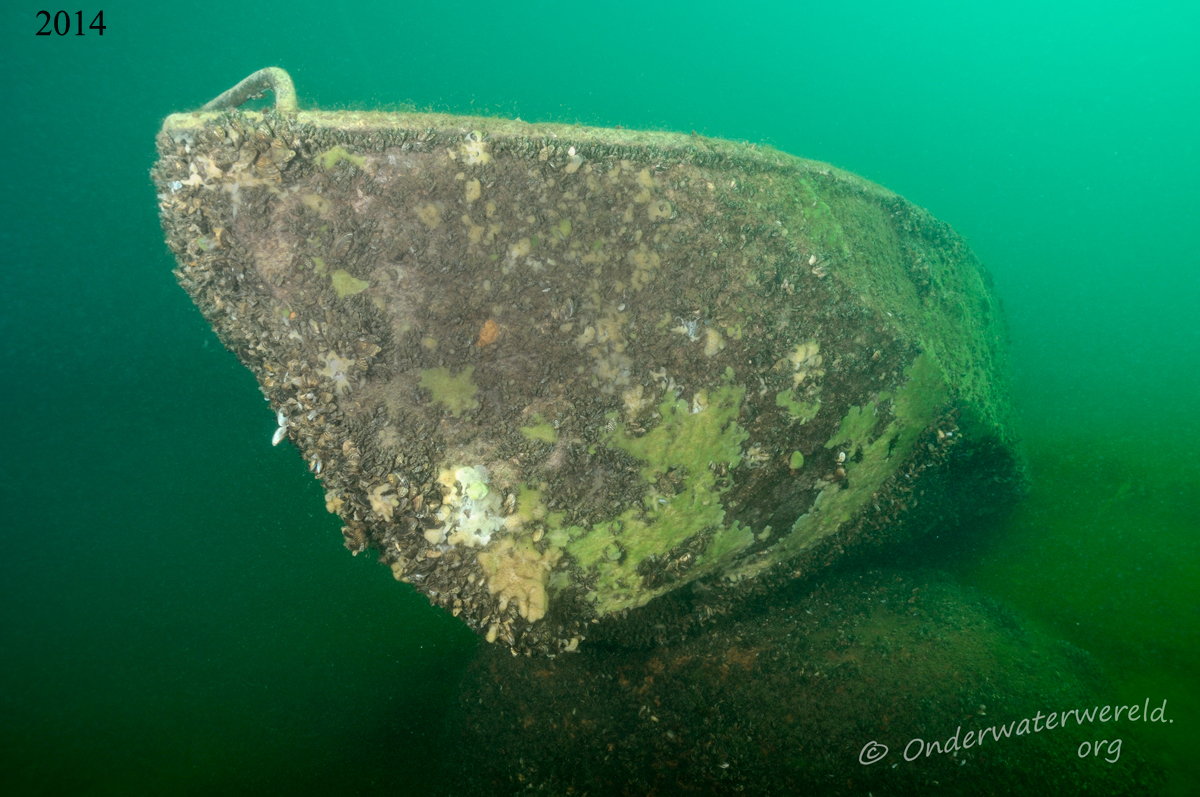

Midden jaren negentig werd de Boschmolenplas afgesloten van de wateraanvoer van de Maas. Erg goed idee. Omdat de Boschmolenplas gevoed wordt door bronnen en er geen Maaswater meer in kon stromen was dit het begin van de prachtige duikplas zoals wij die nu kennen. Tevens had dit tot gevolg dat de veranderingen in het watermilieu of langer op zich lieten wachten of (nog) niet plaats gevonden hebben. Toch heeft zich door de jaren een grote verandering voltrokken in de mosselpopulatie. De grote hoeveelheid mosseltjes die we in de Boschmolenplas zien zijn van Ponto-Kaspische oorsprong.
In de eerste jaren was het de driehoeks- of zebramossel (Dreissena polymorpha) die hier en daar hard substraat bedekte Inmiddels is deze mossel vervangen door de quaggamossel (Dreissena rostriformis bugensis). De quaggamossel plant zich eerder voort en heeft maar een minimaal stukje hard substraat nodig om zich te hechten. Zo kan een schelpje in het zand er al voor zorgen dat daar een hele mosselbank ontstaat, quagga’s hechten zich ook vast op elkaar. De concurrentiestrijd wordt dan ook gewonnen door de quagga. Nu zien we dat veel substraat dat vroeger hier en daar bedekt was met zebramossels nu totaal bedekt is met een dikke laag quaggamossels.
Op de foto’s is het roeibootje te zien in juni 2014 en juni 2015. Het verschil is duidelijk, maar is dat allemaal dan zo erg? Ja en nee. De quagga’s filteren met z’n allen grote hoeveelheden water. Gevolg is zeer helder water wat voor duikers natuurlijk erg leuk is maar de quagga’s filteren ook het plankton eruit. Ze moeten tenslotte eten. Mogelijkerwijs blijft er dan te weinig plankton over voor jonge vis en andere plankton etende organismen. Door het helder wordende water zijn er in andere plassen waar de quagga massaal voorkomt weer planten gaan groeien maar de flora van de Boschmolenplas is altijd al uitbundig geweest. De zwartbekgrondel, ook een exoot, eet quagga’s maar dit visje zit (nog) niet in de Boschmolenplas. Misschien ligt hier ook wel een taak voor de karpers, wie weet, zij eten tenslotte ook mossels. Omdat de quagga nog niet zo heel erg lang in Nederland is zijn de onderzoeken naar deze mossel of nog bezig of nog niet gestart. Kortom, wat er precies gaat gebeuren in een ecosysteem waar quagga’s verschijnen is niet helemaal duidelijk. Voor de Boschmolenplas is het ook afwachten wat er de komende jaren verandert in het ecosysteem. Ondanks dat de Boschmolenplas al helemaal vol zit met quagga’s zien we nu in ieder geval wel nog meer dan genoeg plankton etende organismen. Tijdens een nachtduik wriemelen honderden zo niet duizenden aasgarnalen door het lamplicht.

In the mid nineteens the Boschmolenplas was blocked from the water supply from the river Meuse. This was a good idea. Because the Boschmolenplas is fed by freshwater springs and there was no river water coming in any more this was the beginning of the beautiful divesite as we know it today As a consequence changes in the water environment happened or later or haven’t happened at all (yet). However, through the years there was a big change in the mussel population. The big amount of mussels we see in the Boschmolenplas are originally Ponto Caspian. The first years it was the zebra mussel (Dreissena polymorpha) that covered some hard substratum. Meanwhile this mussel is replaced by the quagga mussel (Dreissena rostriformis bugensis). This mussel reproduces earlier and only needs a minimal piece of hard substratum to attach. So it can be that a little shell in the sand can be the course of a whole new area of quagga’s. They also attach to each other. So the concurrence battle is won by the quagga. Now we see that the substratum that was here and there covered with zebra mussels in the early years by now is covered with a thick layer of quagga’s. On the photo’s there is the rowing boat in june 2014 and june 2015. The difference is clear but is this all that bad? Yes and no. All quagga’s together filter a huge amount of water. The consequence is very clear water, very nice for divers of course but they also filter plankton out of the water. After all, they have to eat. There is a possibility that there is to less plankton for juvenile fish and other plankton eating organisms. Because the water is getting clearer in other lakes where the quagga lives in huge numbers plants will grow again but the flora in the Boschmolenplas always was abundant. The black mouth goby, also an invader, eats quagga’s but this fish doesn’t live in the Boschmolenplas (yet). Maybe here is a task for the carp, who knows, after all they eat mussels to. Because the quagga isn’t that long in the Netherlands yet, the research is still in progress or hasn’t started. In short, what exactly will happen to an ecosystem where the quagga appears is not fully known. We have to await the next coming years to see what possibly happens in the Boschmolenplas. Despite the Boschmolenplas is already full of quagga’s, we see at least for now, more than enough plankton eating organisms. During a nightdive hundreds maybe thousand of mysids swarm trough the light of the lamp.
Zorgeloos duiken en snorkelen begint bij Scuba Adventures Europe. Wij helpen jou de onderwaterwereld te ontdekken met een duikuitrusting die naadloos aansluit op jouw wensen en behoeften.
In onze online en offline duikwinkels vind je als duiker alle benodigdheden om van iedere duik een onvergetelijke ervaring te maken.